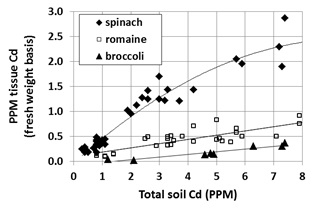For several years the leafy greens industry has been engaged with regulatory agencies regarding the issue of cadmium (Cd) concentration in fresh produce; Cd, a heavy metal element, poses human health risks if ingested in significant quantity. The 2016 production season marks the first time that California spinach growers may be required to alter their production practices to minimize the amount of Cd taken up by this crop. Spinach is the focus of concern because it takes up much more Cd than other common vegetable crops (Fig. 1).
The graph makes clear that soil Cd content is a major factor determining crop Cd uptake. We have a general understanding about where the highest Cd soils are located, but flooding events over centuries have moved and mixed soil sediments. Therefore, soil testing is a critical step in evaluating the field-specific risk. The soil test procedure for which we have the most data is total soil Cd measured by nitric acid/hydrogen peroxide extraction. Soil samples should be taken from the top foot, which is the effective rooting depth of spinach.
In fig. 1 it is clear that individual fields differ substantially from the general trend line relating total soil Cd to tissue Cd because other factors also have influence. Those factors include:
- Variety – preliminary field evaluations suggests that tissue Cd concentration may differ among varieties by up to 25%.
- Soil pH – Cd bioavailability declines with increasing soil pH.
- Irrigation water chloride (Cl) concentration – increasing Cl concentration makes Cd more bioavailable.
- Soil zinc (Zn) level – Zn and Cd compete for plant uptake, so soil with higher Zn availability tend to have less Cd uptake.
Individual spinach shippers may impose soil Cd limits on their growers, or require remediation practices to be deployed if fields above a certain soil Cd level are used; given the uncertainties in the relationship between spinach Cd concentration to total soil Cd, different shippers may set different rules for their growers to follow.
Where growers are required to use remediation practices to reduce spinach Cd uptake, our research suggests that high-rate Zn application is the most practical approach. Zn and Cd are closely related ions, and plants are not able to distinguish well between these ions. Increasing the ratio of plant-available soil Zn to Cd suppresses Cd uptake. However, to significantly decrease Cd uptake much higher levels of Zn application are needed than would typically be used to remedy a soil Zn deficiency. Across numerous field and pot trials we have observed that applying 25-50 PPM elemental Zn on a soil dry weight basis (equivalent to approximately 100-200 lb elemental Zn per acre foot of soil) suppressed crop Cd uptake by roughly 30-60%. However, the effectiveness of Zn application was affected by the following factors:
Zinc form:
- Zinc sulfate and zinc chelate were more effective in reducing Cd uptake than zinc oxide. Zinc sulfate was more economical than zinc chelate.
- Granular forms of zinc sulfate were less effective in reducing Cd uptake than powdered forms, or zinc solutions. We presume that Zn from the granules did not disperse thoroughly through the soil.
Zinc incorporation:
- To be maximally effective, Zn must be distributed throughout the primary rooting zone of spinach (the top 8-12 inches of soil). Zn distributed only in the top few inches of soil was only marginally effective.
- Disking incorporates Zn to a depth of approximately 6 inches and is therefore more effective than mulching, which incorporates Zn only to about 3 inches. Where practical, incorporation of Zn even deeper than 6 inches would be ideal.
Zinc foliar applications:
- Foliar applications of zinc sulfate or zinc chelate were not effective at reducing Cd uptake in spinach.
Zinc longevity:
- When Zn is applied to soil it slowly becomes less plant-available over time, as chemical compounds of low solubility are formed. However, high-rate Zn application will have measurable effects over several years at least. In a field trial, in the first crop following application of 100 pounds of elemental Zn (280 lbs of zinc sulfate) per acre we observed a 40% reduction in Cd uptake by spinach; after two years the Zn-treated area still showed a 15% reduction in crop Cd uptake. In pot trials, when 80 PPM elemental Zn was added to high-Cd soils, the reduction in Cd uptake of four successive spinach crops was 66%, 66%, 51% and 49%. Based on these observations, it is clear that Zn applications can be effective across years, but additional Zn application may be needed to maintain maximum efficacy over the long term.
Other potential remediation practices include raising soil pH, or applying organic amendments. These practices are aimed at making soil Cd less plant-available. Increasing pH does this by precipitating Cd salts, while organic amendments like compost may tie up Cd on its complex cation exchange sites. Our preliminary data suggest that both practices can have a positive effect, but the effects are less substantial than those we observed with high-rate Zn application.
In summary, regulatory pressure is forcing the spinach industry to adopt practices to limit spinach Cd concentration before we have developed a comprehensive understanding of how best to do that. Based on our current data we believe that fields with total soil Cd below 1 PPM present relatively low risk, while those above 2 PPM will be more difficult to remediate reliably. Remediation practices can be effective in fields between 1-2 PPM total soil Cd, but results in individual fields will vary, based on the complicating factors we have outlined.
